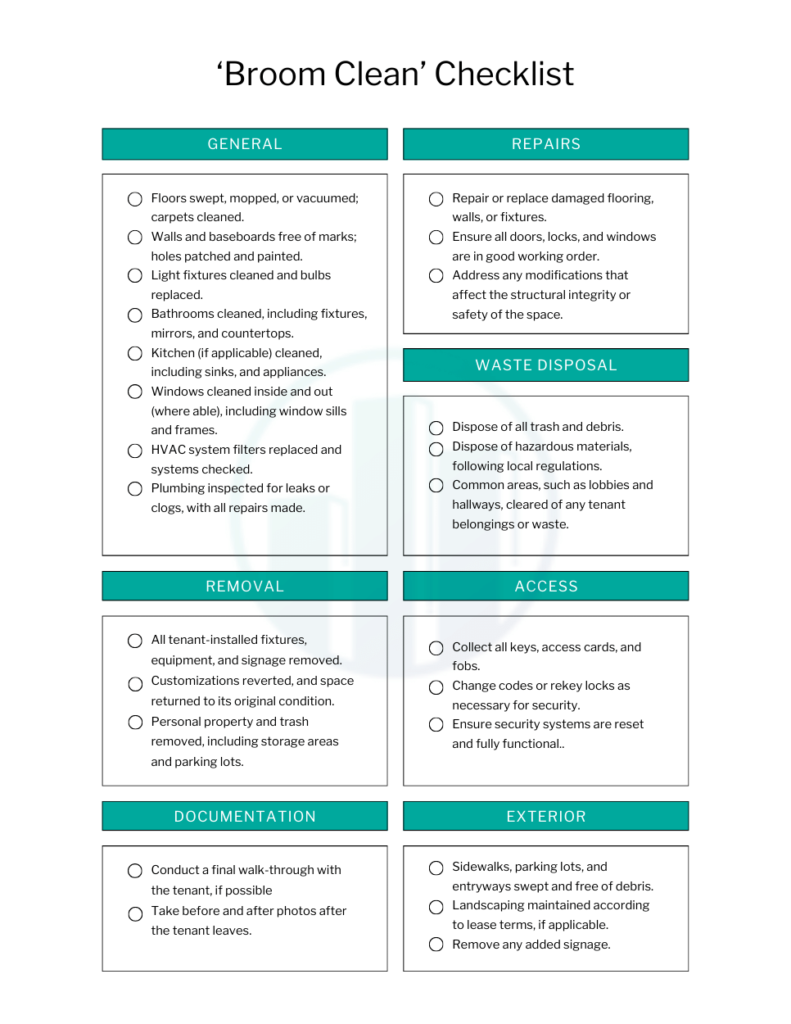The term “broom clean” frequently surfaces at the end of a commercial lease. It’s a seemingly straightforward concept with significant implications for property management at many levels. Ensuring a space meets this standard is key to minimizing vacancy periods and preparing for new tenants efficiently. There’s definitely some legal ambiguity here (which we’ll get into below), but leaving that aside, it’s an important piece of the transition period between tenants.
“Broom Clean” for Commercial Properties
For landlords, “broom clean” (or “broom swept” condition as it’s sometimes referred to) essentially refers to a tenant’s obligation to leave the leased space tidy—free from trash, personal items, and ready for a quick touch-up or the next occupant. However, the term’s vagueness can lead to disputes, making specificity in lease agreements pretty important. For this reason, walkthroughs are very important.
In the commercial context, this condition extends beyond mere cleanliness. It encompasses the removal of any tenant-installed fixtures or alterations, reverting the space to a neutral state. This aspect is crucial for landlords, as it affects the property’s marketability and the ease of transitioning to new tenants. Clarifying “broom clean” expectations upfront can save landlords from potential headaches and avoid unnecessary maintenance costs.
The Difference Between Commercial and Residential “Broom Clean”
When we talk “broom clean” in a commercial lease, it’s a whole different ballgame compared to residential leases.
Commercial “Broom Clean”: Here, it’s not just about leaving the space tidy. Tenants are often required to remove any installations or customizations they’ve made—think shelving units, signage, or specialized equipment. The goal is to return the space to a versatile, neutral state, ready for any type of business to move in. This might include ensuring all lights work, HVAC systems are serviced, and the premises are free from damage beyond normal wear and tear.
Residential “Broom Clean”: In contrast, residential “broom clean” condition typically focuses more on the cleanliness aspect—vacuuming carpets, sweeping floors, and ensuring the property is free of personal belongings and trash. The expectation for returning the property to a “neutral state” is less about removing installations and more about leaving a clean slate for the next resident.
For landlords, clearly defining what “broom clean” entails in your commercial leases can prevent misunderstandings and ensure your property is quickly ready for its next chapter. After all, you don’t want to be stuck holding a $300,000 bag for clean-up after your tenant leaves!
Commercial Broom Clean Checklist for Landlords
This detailed checklist is designed to guide landlords in setting clear, comprehensive expectations for tenants upon lease termination, ensuring a smooth transition for the next occupant. We’ve created a downloadable Broom Clean Checklist in PDF form as well in case you want to give it to tenants so they know what to do to reach the broom clean condition you want.

General Cleanliness and Maintenance
- Floors swept, mopped, or vacuumed; carpets cleaned if present.
- Walls and baseboards free of marks; holes patched and touched up with paint.
- Ceilings checked for damage or stains; light fixtures cleaned and bulbs replaced as needed.
- Bathrooms thoroughly cleaned, including fixtures, mirrors, and countertops.
- Kitchen or break area (if applicable) cleaned, including sinks, countertops, and appliances.
- Windows cleaned inside and out (where accessible), including window sills and frames.
- HVAC system filters replaced and systems checked for proper operation.
- Electrical outlets and switches checked for safety and proper function.
- Plumbing inspected for leaks or clogs, with all repairs made.
Removal of Tenant Installations and Personal Property
- All tenant-installed fixtures, equipment, and signage removed unless otherwise agreed upon.
- Customizations reverted, and space returned to its original or agreed-upon condition.
- Personal property and trash removed from the premises, including storage areas and parking lots.
Repairs and Damage
- Repair or replace damaged flooring, walls, or fixtures.
- Address any modifications that affect the structural integrity or safety of the space.
- Ensure all doors, locks, and windows are in good working order and secure.
Waste Disposal and Environmental Compliance
- Ensure proper disposal of all trash and debris.
- Special attention to the disposal of hazardous materials, following local regulations.
- Common areas, such as lobbies and hallways, cleared of any tenant belongings or waste.
Keys, Access, and Security
- Collect all keys, access cards, and fobs issued to the tenant.
- Change codes or rekey locks as necessary for security.
- Ensure security systems are reset and fully functional.
Exterior and Shared Spaces
- Sidewalks, parking lots, and entryways swept and free of debris.
- Landscaping maintained according to lease terms, if applicable.
- Signage removed or restored to pre-lease condition.
Documentation and Final Inspection
- Conduct a final walk-through with the tenant, if possible, to document the condition.
- Take photographs before and after the tenant’s departure for records.
- Provide the tenant with a signed checklist acknowledging the condition of the space upon return.
This is an expanded checklist, and covers things that may not directly apply to your specific broom clean clause. Feel free to add or take away anything here that isn’t applicable to your property.
Sample Clause for “Broom Clean” in Commercial Leases
To avoid ambiguity and ensure both parties have a clear understanding of expectations, incorporating a detailed “broom clean” clause in your commercial lease agreements is crucial. Below is a sample clause template that you can adapt to fit the specific needs of your property and leasing agreement. That said, each situation is different, and it would be wise to consult with an attorney before making your customized clause and putting it into a lease.
Broom Clean Condition Clause Template:
“Upon the expiration or earlier termination of this Lease, Tenant agrees to surrender the Premises to Landlord in a ‘broom clean’ condition, which shall mean the Premises are free of all debris, rubbish, and personal property, with all floors swept and washed, carpets vacuumed, and bathrooms and kitchen or break areas (if applicable) cleaned. Tenant shall remove all of its signage, fixtures, and equipment, and repair any damage resulting from such removal. Tenant shall also repair any damage to the Premises caused by Tenant’s use beyond normal wear and tear. All keys, access cards, and security codes shall be returned to Landlord on or before the last day of tenancy. Failure to return the Premises in such condition may result in Landlord undertaking necessary cleaning or repairs at Tenant’s expense.”
This clause sets clear expectations for the condition of the property at the end of the lease and outlines the responsibilities of the tenant in maintaining and returning the property. It also provides a basis for the landlord to recover costs if the property is not returned in the specified condition.
Conclusion
The broom clean/swept condition is more than a clause in a lease; it’s a principle that ensures properties are efficiently prepared for new tenants so that their value and appeal are easily seen. Clear communication strategies, detailed expectations, and fostering a cooperative relationship with tenants not only minimizes potential disputes and turnover times, but also contributes to a positive leasing experience for all parties involved. Cross your T’s and dot your I’s!

